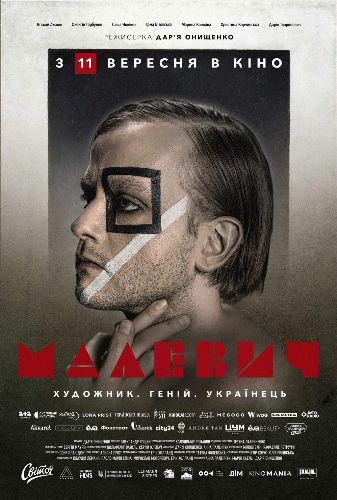
© facebook Andrey Nedzelnitsky
Події у фільмі розгортаються навколо ключових етапів життя художника Казимира Малевича у 1910–1930-х роках: презентацію «Чорного квадрата» та супрематизму, викладацьку діяльність у Вітебську, створення УНОВІС, арешт і роботу в Київському художньому інституті. Команда фільму вже розгорнула промокампанію: у київському метро курсує тематичний поїзд, а в театрі Франка триває виставка з репродукціями картин та реквізитом.
Андрій Недзельський - відгук про кінофільм.
Иногда, знакомлюсь с фильмами в плане фестивалей, и собственно, хоть и мне достаточно небольшой зарисовки, пытаюсь написать обо всем, к чему прикоснулся. просто вместе с коллекционированием автографов (хоть конечно не систематизируя) знаю, что это "сыграет".
Пример - фильм режиссера Дарьи Онищенко "Малевич", который видел на одном из фестивалей и который выходит в прокат. Лента пытается раскрыть выдающегося художника (хоть, честно говоря, автору этих строк данное направление искусства несколько чуждо) и в украинской культуре. Лента разбита на четыре части. поскольку все основные произведения художника принадлежат российским музеям, авторы знакомят нас с романтической встречи солдата с любимой на передовой и фоном ее - это квадрат. собственно с этого и начинается история. собственно фильм очень неоднороден. собственно "зачин" в современности и первая глава о представлении легендарного квадрата в Петербурге - смотряться живо, и как бы авторы решают сложный вопрос. Но потом фильм переходит в откровенную, скучную, везде похожую во всех остальных картинах, и здесь явно отсебятину исключительно в противостоянии художника и советской власти. настолько скучно, что просто хочется выйти из зала, аж до абсурдных ситуаций. Следователь дважды приходит с ордером арестовать художника, и арестовывает всех, кроме Малевича. как-то так. сыграно очень неплохо, так, живо, но увы в ленте есть водораздел, когда тебе мягко говоря становится невыносимо скучно. Но в принципе конечно, и сам фильм представляет выбор: либо конечно добровольно участвовать в театре абсурда, либо конечно жить живым, полнокровным воображением, пережить и даже увидеть что-то из оригиналов вживую - кстати, последний квадрат был "случайно" найден уже в 90-е годы, и попал в Эрмитаж. и поскольку этот текст без протокола, то обзоры добавил в комментарии.
Казимир Малевич (1879–1935) — художник-авангардист, теоретик мистецтва, педагог. Один із найвпливовіших митців ХХ століття та засновник художнього напряму супрематизм. Народився у Києві в родині польського походження. Навчався у Київській та Московській художніх школах.. За життя зазнавав переслідувань з боку радянської влади, був заарештований.
The events of the film unfold around the key stages in the life of the artist Kazimir Malevich in the 1910s–1930s: the presentation of the “Black Square” and suprematism, his teaching activities in Vitebsk, the creation of UNOVIS, his arrest, and his work at the Kyiv Art Institute. The film’s team has already launched a promotional campaign: a themed train is running in the Kyiv metro, and the Franko Theatre is hosting an exhibition with reproductions of Malevich’s paintings and props from the set.
Andrii Nedzelskyi – a review of the film.
Sometimes, when I discover films at festivals, even if just in brief encounters, I try to write about everything I have experienced. Alongside collecting autographs (albeit unsystematically), I know this will “play its part.” An example is director Daria Onyshchenko’s film Malevich, which I saw at one of the festivals and which is now being released in cinemas. The film attempts to portray the outstanding artist (although, frankly, this particular art form is somewhat alien to me) within Ukrainian culture. The picture is divided into four parts. Since most of Malevich’s main works belong to Russian museums, the authors introduce us through a romantic frontline meeting between a soldier and his beloved, set against the backdrop of the Square. That is where the story begins.
The film itself is very uneven. The prologue in contemporary times and the first chapter — depicting the presentation of the legendary Square in St. Petersburg — feel vivid, as if the creators successfully solved a complex challenge. But later the film slips into an overtly tedious narrative, resembling countless other films, relying too heavily on the theme of the artist’s confrontation with Soviet power. It becomes so dull that one simply wants to leave the hall, with even absurd situations: the investigator twice comes with a warrant to arrest the artist, yet arrests everyone except Malevich. Performances are solid, lively even, but unfortunately the film contains a turning point where, to put it mildly, it becomes unbearably boring.
Yet in principle, the film still offers a choice: either voluntarily take part in a theatre of the absurd, or live with full-blooded imagination, endure, and even see some of the originals in person. Incidentally, the last Black Square was “accidentally” discovered in the 1990s and ended up in the Hermitage. And since this text is informal, I’ve added extra observations in the comments.
Kazimir Malevich (1879–1935) — avant-garde painter, art theorist, and teacher. One of the most influential artists of the 20th century and the founder of the suprematist movement. He was born in Kyiv into a family of Polish descent. He studied at art schools in Kyiv and Moscow. During his lifetime he suffered persecution by Soviet authorities and was arrested.
1282